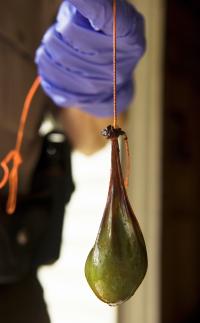Bear gall bladder trafficking for traditional Asian medicine

By Sacha Chadwick
A surprisingly unheard of phenomenon in many Western countries, bear gall bladder consumption is very popular in the Eastern and Southern Asian regions, most notably in Japan, China, and South Korea. What Westerners would consider ‘strange’ and peculiar, the Asian community would see as a lifestyle choice. Bear gall bladder consumption historically has been a part of Asian traditions, with research showing that its retail sale goes as far back as the 18th century. Despite this being a well known in Asian communities, it is also a potential crime. Its collection and sale is prohibited by international law.
Traditional Chinese medicines have often included various parts of the bears throughout the years; this includes brains, paws, bone, etc. However, there is one part of the bear that is heavily desired. That is the bear’s gall bladder and the bile in the bladder. Research has shown that the bile in the gale gladder as well as the bladder itself can exceed the cost of illegal narcotics. Individuals who use traditional Chinese medicine often believe that the bear gall bladder treats life-threatening cancers, burns, pain and redness of the eyes, asthma, sinusitis and pain in general. The question is what causes the public to believe this? Research has shown that bears are the only mammals that can produce a significant amount of the bile acid tauroursodexucholic (UDCA) and this has been linked to improved liver and muscle functioning.

Consequently, China has constructed bear bile farms where nearly 10,000 bears are kept and bile is routinely drained from live bears through devices implanted surgically in their gall bladders. Traditional Chinese medicines recommend the use of Asiatic Black bear or Brown bear bile use, due to their readily availability. Unfortunately, due to these practices, the Asiatic Black and Brown bear’s wild population has been depleted. As a result, the Convention on International Trade in Endangered Species of wild fauna and Flora (CITIES) created an international ban from gale bladder trafficking in Bhutan, China, and Mongolia. However, domestic trade remains legal in some cases, for example in Japan.
Japan is unique among the East Asian markets because it has its own substantial wild populations of Asiatic Black and Brown Bears. Hunting bears and selling their gall bladders is legal. On average, nearly 20 percent of Japan’s Asiatic Black Bear population and more than 14 per cent of its Brown Bear population are killed each year for sport and nuisance animal control. Prices paid to hunters for gall bladders vary, ranging from US$2,000 to US$10,000 each.
Bear gall bladder trafficking is a growing and an interesting crime to study. Recent studies have shown that due to a decrease in the bear population in Japan, government officials have questioned whether allowing the legal sale of bear gall bladders is acceptable. As research increases, more questions will be answered and more solutions will emerge.
 Sacha Chadwick is a student in the International Crime and Justice Masters Program at John Jay College of Criminal Justice. Her interests include wildlife crimes and countries’ compliance and non-compliance with the Kyoto Protocol.
Sacha Chadwick is a student in the International Crime and Justice Masters Program at John Jay College of Criminal Justice. Her interests include wildlife crimes and countries’ compliance and non-compliance with the Kyoto Protocol.